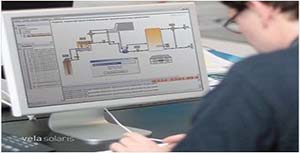Greetings!
A few weeks ago we sent out a newsletter with some background to Solar Water heating Collectors and how the Solar Radiation in your area affects the heat output from the Collectors. To follow on from that, this newsletter will try to explain where you can find the test report data for the Solar Collectors and what it means. Also, we will do a bit of high school maths to show you how you can calculate the power output of the solar collectors and how it relates to real life.
Solar Collector Testing and Marketing
Most solar water heating panels are tested by the different testing agencies and a graph and report is produced showing the output of the panels, such as this below for our collectors.
This test report was submitted to NRCan and approved for the residential and commercial Solar Hot Water Incentives and Grants.
Most of the world uses units of Energy in Watts and Joules however in Canada and North America water heating systems are measured in BTU's. Most the Solar Collectors that have been used for years in Europe have test reports in "Watts".
The SRCC and CSA are letters thrown around the solar industry very freely. We have a section on our FAQ page that goes into more detail on the certification side of Solar Collectors and how the CSA is involved, however the Canadian Government Solar incentive program lists a lot of Collectors that have been tested by different agencies around the world. So long as they have been tested to CSA Standard F 378-87 then they qualify for the ecoENERGY incentive program.
A full list of approved collectors can be found here - ecoENERGY Approved Collectors. We are listed about 7 companies up from the bottom of the Evacuated Tube List.
Our Solar Collectors have a tested MAXIMUM Power of 1762 Watts. Note the graph slopes down to the right. The power output of all collectors drops like this, its related to the efficiency of the heat transfer when the Delta T (temperature difference) increases, i.e. When the outside temperature is very low and the inside water temperature is high then the efficiency of the collectors falls. The slope of this graph is different for all collectors. Both Flat Plate collectors and Evacuated Tube Collectors behave a similar way but in general the graph is steeper for Flat Plate Collectors (ie less efficient when it is cold outside). The slope of this graph is built into the Data for each collector that is used in Retscreen to calculate the power output of the collectors.
The better the collector is at insulating the outside temperature the more efficient it is when it is cold outside.
How much is 1762 Watts?
Your kettle in your house will be somewhere between 1000 or 2000 Watts (1 or 2 KW)
Hence as a comparison our panels are equivalent to a Kettle! Now this doesn't sound much, however imaging what it would cost to heat your 50 gallon water tank using your kettle for the next 20 years. The Solar Collectors will be heating the water for years and decades to come using free energy from the sun - This is why Evacuated Tube Collector are so efficient at heating water.
"There are lies, damn lies and statistics"
Our collectors were tested by the TUV testing facility in Germany which qualifies under the CSA F378-87 standard for use in Canada. The SRCC is an American Testing Facility and reports the heat produced in BTU's. Our collectors are also going through the SRCC tests as well but the whole process takes about 18 months and costs about $50,000. We already have certifications that are approved by NRCan and the ecoENERGY program, the SRCC will be an extra certification. In the end though, it doesnt matter which test facility is used.
The SRCC Data is used for some very clever marketing by some Collector Manufacturers. I won't name the company but this company sells Flat Plate Solar Collectors. The Flat Plate crowd like to tell everyone the Flat Plates Collectors are much better than Evacuated Tube Collectors. Quick Visit to the SRCC website can show this claim as complete nonsense, the official data does not support this claim.
On the SRC webpage there are reports showing the heat produced by dozens and dozens of different Solar Panels. (This page might take a while to load)
The sneaky Marketing flyer I have from this Flat Plate Manufacture likes to quote its "Look how many BTU's our collectors Produce" from the Warm Climate section of the report. These "warm Climate" conditions are great if you live in Hawaii but not in Canada. This link will show how evacuated tubes collector can produce 12 times the heat that the Flat Plate Collector can. For details of this and some screen shots of the SRCC data sheets, click this link to view on our website
Hence in the end it comes down to Cost per BTU.
For example, there are Evacuated Tube Solar Collectors for sale by other companies in Canada stating their Maximum Power output is about 650 Watts! They are for sale for about $1200. As our collectors produce 1762 Watts and we sell for $1100 Watts there is clearly almost 3 times the heat output on our collectors.
Last we heard, Flat Plate Collectors cost about $1250 each, they normally always install 2 Flat Collectors so you can get some heat in the winter months, hence you are paying $2400 just for the collectors.
When you get a quote for a Solar water Heating system, remember this fact, a Flat Plate Collector system might be a bit cheaper to install but it can produce much less heat. If you don't know that the Evacuated Tube Collectors produce more heat then obviously the cheaper system will look good, but will not produce as much heat.
We sell our Collectors for $1100 Each and they produce (based on Calgary climate ) 38 000 BTU on average and will produce MANY times the heat than a comparably priced Flat Plate Collector will.
In the end there is only one reliable way we have found to find out how a collector will work in your climate, and that is use RETSCREEN - see here
How much Hot Water Will Latitude51 Solar Panels Produce.
This section will do some basic maths showing how to calculate water heating. This might be of no interest to most of you but it will give the DIY people some information on why you need about 50 Gallons of Storage for every collector installed.
Definition 1) A Watt is equal to 1 joule of energy per second. It measures a rate of energy conversion.
Definition 2) It takes approximately 4200 Joules to heat 1 litre of water by 1 Degree Centigrade.
Definition 3) 1 BTU is approximately 1055 Joules. Hence 10,000 BTU = approx 10.5 Million Joules.
Relating Energy to Water heating.
Almost every one will have an electric kettle in their house. For example it could be a 2 KW Kettle (2 KiloWatt or 2000 Watts)
If you have 1 litre of water in the kettle and it is already at 10 degrees C (Tap water) then to boil the kettle you will need to raise the temperature by 90 degrees C
How many joules to heat the water?
Joules = 4200 x 1 (litre) x 90 (DegC)
= 378,000 Joules
The kettle is a 2 KW Kettle (2000 Watts - Remember the DEFINITION 1) Above, 1 Watt = 1 Joule of energy per second.)
So 378,000 Joules divided by 2000
= 189 seconds to boil the kettle.
Solar Panels and Domestic Water
If each latitude51 Solar Collector, based on Retscreen Climate Data for Calgary, will produce on average 38,000 BTU per day. 38,000 BTU = approx 40 Million Joules of energy per day.
If you have a 50 USGallon tank (or 200 Litres), to heat the water in the tank from 10 Deg C to 54 Deg C (54 DegC = approx 130 Deg F which is the temperature your water heater is usually set to)
Equation is the same as above...
Joules = 4200 x 200 Litres x Temp Difference in Deg C
= 4200 x 200 x (54 - 10)
= 36,960,000 Joules
As we stated above, each panel produces about 40 Million Joules in a Day on average. This is why we recommend that each Panel has approx 50 Gallons or 200 Litres of storage because one panel will heat the tank up to shower temperatures in one day. Remember that this is an average number, in the summer the panels will produce more heat and in winter will produce less. In the summer the tank temperature could easily be up to 180 Dec F. This is why it is necessary to size the system properly because once it gets to +180 Deg F there needs to be a way of dumping the excess heat to cool down your system.
Remember when you go away on holiday, there is no-one using the water in the house. You tank will get very hot! This is why you need to size the system properly, a tank with no way of shutting off the heat can be very dangerous.
Different Solar Collectors from Different Manufactures will produce different amounts of heat. You might need to adjust the calculations.
I hope you found this useful. If you have any suggestions for future topics, let us know and we will try to include them in future news letters.
Sincerely,
latitude51 solar



